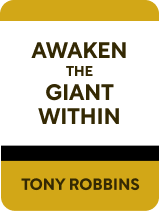

This article is an excerpt from the Shortform book guide to "Awaken the Giant Within" by Tony Robbins. Shortform has the world's best summaries and analyses of books you should be reading.
Like this article? Sign up for a free trial here .
What are Tony Robbins’ beliefs for empowerment? How do your beliefs impact your life? What can you do to overcome disempowering beliefs?
According to Tony Robbins, beliefs control how you interpret and react to your life experiences. Tony Robbins’ beliefs for empowerment will help you reach your goals and navigate life in a positive way while disempowering beliefs perpetuate negative thoughts and harmful behavior.
Find out more about Tony Robbins’ beliefs for empowerment below.
Tony Robbins: Beliefs for Empowerment
In this article, we’ll discuss:
- What beliefs are, and how they form
- Different types of beliefs, such as global beliefs and limiting beliefs
- How your beliefs impact your life
- Tony Robbins’ beliefs for empowerment, and how you can change your beliefs to empower you to reach your goals
For Tony Robbins, beliefs lead from and to your neuro-associations: Your collective pain and pleasure neuro-associations form your beliefs, which then influence your behavior, while also reinforcing those neuro-associations. Here’s how it works, along with an example to illustrate the circular relationship between neuro-associations and beliefs:
- You have an experience. For example, you take a flight during a busy holiday weekend.
- You interpret that experience as painful or pleasurable. For instance, you find the large crowds and hectic atmosphere to be stressful (painful).
- Per your interpretation, you form a pain or pleasure association with the experience. For instance, you associate pain with this holiday flight.
- Your brain looks for patterns among your painful and pleasurable experiences in order to form generalizations. These generalizations are then used as predictive shortcuts, enabling you to quickly assess whether something is likely to be painful or pleasurable. For example, your brain recalls other unpleasant instances of holiday travel.
- Your generalizations inform beliefs about situations and events. For example, you form a belief that traveling over the holidays is always stressful.
- Next time you have a similar experience, your beliefs color your interpretation of it, creating a feedback loop. For instance, next time you have to travel during the holidays, you expect it to be stressful and unpleasant—and because you’re expecting to be stressed, that’s what you experience. Now you have another painful travel experience (called a reference, which we’ll talk about next) to add to your mental library and support your belief about holiday travel.
- Your interpretations of experiences impact your decisions, which collectively shape your life. For example, you may avoid traveling during holidays, which brings other ripple effects. On one hand, it gives you an opportunity to establish a tradition of having quiet, restful holidays. On the other, it could prevent you from attending gatherings with friends and family.
Appreciate the Importance of References
While your generalizations about neuro-associations form your beliefs, your sense of certainty in those beliefs strengthens them. Without your certainty, a belief is merely an idea that holds little power over you. Your sense of certainty in a belief is based on the experiences that you’ve interpreted as evidence—or references—to support the belief. For example, if you believe that you can do anything, your references may be your past achievements.
There are different types of references, some of which are stronger than others. We’ll discuss references in detail in Part 2 of the summary, but for now, here’s a brief overview of the different types of references you may have:
- Personal experiences, which are the strongest references, especially when there’s a lot of emotion attached to the experience
- Information from other people, either directly or through characters’ experiences in books and movies
- Imaginings, meaning that you vividly envision whatever you need to be true to develop certainty in a belief. For instance, if you want to believe that you’ll succeed in life, but have no experiences or information to support this belief, you might imagine yourself succeeding. Imagining allows you to create references for any belief you want to adopt, simply by visualizing it happening, thus giving you the power to create and adopt beliefs that empower you.
When you combine an idea and your certainty, the results are powerful: Your certainty doesn’t make an idea more or less true, but it does affect whether you tap into the resources to turn that idea into reality. For example, if you believe that you can achieve anything, then you’ll be more motivated to work hard and make it happen. By contrast, if you didn’t believe that you could achieve anything, then why would you waste your effort on trying?
Your beliefs are so powerful that they can actually influence your physiological responses to events. In one experiment that illustrates this, 100 medical students were given either a red or a blue pill. They were told that the red pill was a stimulant and that the blue pill was a depressant. In reality, the pills each contained chemicals that did the opposite—the red was a depressant and the blue was a stimulant—but the students’ expectations overrode the actual chemical reactions in their bodies, and they had physical reactions that aligned with their false beliefs of what the pills would do.
Recognize the Three Categories of Beliefs
There are three categories of beliefs—opinions, beliefs, and convictions. Each category affects your behavior in a different way:
- Opinions are the weakest form of belief, because they’re supported by temporary, changeable references. Often these references are based on impressions, like when you form an opinion about someone based on a few limited interactions—as you learn more, that opinion could easily change.
- Beliefs stand on stronger certainty, and people often have strong emotions tied to them. As previously noted, the references for beliefs may be experiences, information from others, and vivid imaginings. People are typically unwilling to entertain any information that contradicts their beliefs, but if you have a close relationship with someone, you may be able to get them to hear you out.
- Convictions are the strongest beliefs of all because they’re anchored by intense emotions. When you hold a conviction, you get angry if anyone even questions the conviction or the references upon which it stands.
There are two important distinctions between a conviction and a belief:
- Convictions are strong enough that they motivate you to take any action to uphold them. If you’re an extremist with a conviction, that could mean killing nonbelievers. If you’re a determined entrepreneur with a conviction, you’re willing to do anything to make your business successful. On the other hand, beliefs are motivating but they don’t lead to such extreme action.
- Convictions are created during and upheld by such intensely emotional experiences that you associate a threat of extreme pain with questioning or letting go of the conviction. Your certainty in that conviction becomes part of your identity, and you fear that if your conviction were to waver, then you wouldn’t be you. This extreme unwillingness to even question your conviction is dangerous, especially if the conviction is harmful to you. By contrast, you hold your beliefs strongly but you could be influenced to change them under the right circumstances.
While negative convictions can doom you to a pattern of destructive behavior, positive convictions can be the key to achieving at high levels. Since convictions push you to take action, they motivate you to persevere through obstacles to reach your ultimate goal. For example, a conviction that you’ll finish your undergraduate degree within four years will push you to carry on through tough classes and busy semesters. To turn a positive belief into a conviction:
- Find ways to add powerful, emotional references to strengthen that belief.
- Find or create emotionally triggering experiences that increase the intensity of pain you associate with not upholding your belief.
- Take actions to uphold your belief—just as convictions drive you to act, acting will reinforce your conviction.
Understand Specific vs. Global Beliefs
Some of your beliefs pertain only to certain areas of your life—for example, perhaps you believe in your ability as a skilled pianist, but you believe that you’re incompetent as a cook. This is a specific belief. By contrast, some beliefs are global, meaning that you overgeneralize and believe that you’re either skilled or incompetent in everything you do. Global beliefs are often phrased with the declarative verb “is,” “am,” or “are,” as in “People are good at heart.”
Whether or not they’re measurably true, people accept their beliefs as facts. Considering this, global beliefs can be powerful forces for positivity or negativity: A single negative global belief can be destructive. On the other hand, one positive global belief, or a positive change to a formerly negative belief, can be hugely empowering.
Break Free From Limiting Beliefs That Sabotage You
Sometimes, as your brain is generalizing and creating beliefs about a difficult, complex experience—for instance, a failure—it oversimplifies the experience and comes to a false conclusion. This creates a limiting belief: a false, overly simplistic negative belief that holds you back from doing things that you want to do and that would benefit you.
For example, if you’re trying to start a business and you’ve failed at your first few attempts, your generalization may lead you to believe that you’ll always fail as an entrepreneur because you’re just not cut out for it. This belief doesn’t take into account the fact that entrepreneurs often fail before they succeed and that many goals can only be achieved after several failures, which provide the lessons necessary to ultimately succeed. Instead, your generalization focuses on the pain you’ve felt through your multiple failures, and it creates this limiting belief to deter you from trying and potentially failing again to protect you from more pain in the future.
Limiting beliefs can become self-fulfilling prophecies, as they inform your decisions, which dictate your actions, which shape your future. For example, your limiting belief about your potential as an entrepreneur could prevent you from trying again to launch your startup, which means you’ll never realize your dream of owning your own business.
To break your limiting beliefs and pursue your goals despite your past failures, rely more heavily on references of imagination rather than experience. In other words, instead of basing your beliefs on experience-based references that provide evidence of you failing, focus on imagination-based references and vividly envision yourself accomplishing your goal.
Take Control of Your Beliefs
Now that you’ve learned about the different types of beliefs, it’s time to use that knowledge to assess and change your own beliefs to improve your life. Take control of your life by ensuring that all of your beliefs empower you to reach your goals.
First, notice what your beliefs are. Although they influence just about everything you do, most people aren’t consciously aware of their beliefs. In fact, since our beliefs come from our brains’ attempts to generalize our experiences, we generally adopt beliefs subconsciously without ever evaluating them.
This can create problems when our beliefs are limiting or when they’re based on our brains’ misinterpretations of events (such as the entrepreneur falsely attributing her failures to her incompetence instead of external factors). Once we adopt beliefs, we seldom question them, which means that we can carry around self-destructive beliefs that impede us from reaching our dreams—and we may never even realize it. This is why it’s critical to take a full inventory of your beliefs.
Second, as you evaluate your beliefs, take note of the references upholding them. Many people form beliefs based on the mere fact that other people hold the same beliefs. However, assuming that something is accurate because other people believe it to be—a phenomenon called “social proof”—is dangerous and limiting because it prevents you from surpassing the status quo and living to your full potential. For example, everyone believed it was impossible to run a mile in under four minutes—until Roger Bannister did it in 1954. Bannister refused the social proof and broke the record, and, as soon as he did, scores of other runners were suddenly able to do the same.
If you want to reach your greatest potential, you’ll have to hold beliefs and convictions that are uncommon and even contrary to popular belief. Find someone who’s living the way you want to live. Ask this person what she believes that sets her apart from others so that you can adopt the beliefs that made her successful.
Finally, use the six steps of Neuro-Associative Conditioning (NAC) to recondition yourself to release disempowering beliefs and adopt empowering ones.
Apply It: Change Your Beliefs
With the knowledge that beliefs you probably didn’t even realize you had are impacting your life every day, follow these steps to take stock of these beliefs. Hold onto the beliefs that are helping you, and change the ones that are holding you back.
First, spend 10 minutes writing a list of all of your beliefs, both empowering and disempowering. Be sure to include:
- Global beliefs
- “If-then” beliefs, such as, “If I try hard, I will succeed”
- Beliefs about yourself
- Beliefs about abundance and scarcity—for example, do you believe that everyone can enjoy wealth, joy, and success (abundance mindset), or that someone has to lose in order for someone else to win (scarcity mindset)?
- Beliefs about opportunity—for example, do you believe that opportunities are hard to come by, or that they are everywhere if you just look hard enough?
- Beliefs about time—for example, do you believe that there are never enough hours in the day, or that there is always enough time to do the things that matter most?
Second, look over your list and circle the three beliefs that are most empowering. Commit to strengthening these beliefs, and use the strategies we discussed earlier in this chapter to turn those beliefs into convictions.
Third, circle the two beliefs that are most disempowering. Think of the consequences that you suffer due to holding these beliefs. Vow to let go of these beliefs, and begin by asking yourself questions to dismantle them, including:
- In what way(s) is this belief ridiculous?
- Who did I learn this belief from, and is this person a worthy role model?
- What is the emotional cost of letting go of this belief?
- What is the cost of holding onto this belief? How does it affect my relationships, my physical well-being, my finances, or my family?
Consider the answers to these questions, and link severe pain with these disempowering beliefs.
Finally, write down new, empowering beliefs to replace each of the disempowering beliefs. Think of the references you have to support these new beliefs, and commit to strengthening them through your actions.
In the future, if you feel that disempowering beliefs may be holding you back, uncover the culprit by asking yourself what belief would cause you to behave the way you are. For example, if you’re feeling discouraged, you may realize that believing that you don’t have what it takes would make you feel that way. Identify this belief, and then consciously reject it. Then, create a new, more positive belief by working backward: Consider the results you want, and ask yourself what you’d have to believe in order to achieve that.
Tony Robbins: Beliefs Exercise
Use the techniques from this chapter to replace a disempowering belief with an empowering one.
- Describe one behavior you feel you should stop doing. Why do you want to abandon it?
- Think backward: What belief must you have that is causing you to behave in this way? Where did you get this belief?
- What is the price of holding onto this belief? For example, how is it harming your emotional, spiritual, professional, or financial life?
- Describe an empowering belief that you can adopt to replace the old, disempowering one.

———End of Preview———
Like what you just read? Read the rest of the world's best book summary and analysis of Tony Robbins's "Awaken the Giant Within" at Shortform .
Here's what you'll find in our full Awaken the Giant Within summary :
- How to make transformational changes to your life through small adjustments
- How you create your destiny every time you start a sentence with “I am…”
- Strategies to take control of your thoughts and emotions






